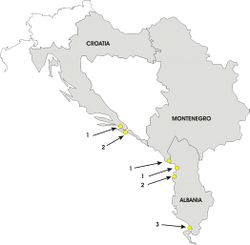Sand dune - Country Report, Croatia, Montenegro and Albania
This article on the sand dunes of Croatia, Montenegro and Albania, is a revised country report from the 'Sand Dune Inventory of Europe' (Doody ed. 1991) [1]. The 1991 inventory was prepared under the umbrella of the European Union for Dune Conservation [EUDC]. The original inventory was presented to the European Coastal Conservation Conference, held in the Netherlands in November 1991. It attempted to provide a description of the sand dune vegetation, sites and conservation issues throughout Europe including Scandinavia, the Atlantic coast and in the Mediterranean.
An overview article on the distribution of European sand dunes provides links to the other European country reports. These represent chapters from updated individual country reports included in the revised, 2nd Edition of the 'Sand Dune Inventory of Europe' prepared for the International Sand Dune Conference “Changing Perspectives in Coastal Dune Management”, held from the 31st March - 3rd April 2008, in Liverpool, UK (Doody ed. 2008)[2].
Status: Original authors: Veronique Loeffen & Robert Tekke, original text with minor revisions and a revised map, 2008
Contents
Introduction
The rocky nature of much of the coastline and relatively limited information on sand dunes at the time of production of the inventory is the reason for amalgamating these descriptions. Croatia, Montenegro and Albania border the Adriatic Sea. The Croatian coastline is 6,116km, including 4,024km of islands. Montenegro has a much shorter coastline and Albania is just 400km. The coasts of these countries mainly consist of rocky shores and cliffs. Sandy beaches and dune areas are very scarce. Current information suggests there are just six dune areas of any size. This is likely to be a major underestimate.
Distribution and type of dune
Dunes occur only locally on the mainly limestone east coast of the Adriatic Sea, but in Albania they are found on beach ridges associated with deltas, notably the Seman River delta. The dune areas in the countries mainly coincide with coastal lagoons. These lagoons occur close to the mouths of rivers, for example near the River Drini in the north of Albania. The dunes are relatively small and normally only consisting of beaches and foredunes. These foredunes are partly mobile and partly stabilised.
Vegetation
The vegetation in the coastal dunes is similar in composition and the summary of the plant communities given below serves for all areas.
Strandline
This zone is mostly dominated by Salsola kali, Eryngium maritimum, Echinophora spinosa and Medicago marina;
Foredune and dune
The vegetation of this zone is characterised by Ammophila arenaria, Agropyron junceum, Eryngium maritimum, Medicago marina and Euphorbia paralias. In the more inland, Stabilised parts of the foredunes species like Pancratium maritimum and Scirpus holoschoenus become more prominent.
Important sites
Conservation
Not much information is available on the threats and conservation of the dune areas in these countries.
Along the coastline of Croatia, most of the coast is urbanised. The beaches and the only major dune area, Ulcinj, are under threat from tourist development. The beaches are mechanically cleaned, and the building of tourist facilities destroys the dunes and their vegetation. The dunes of Ulcinj are also threatened by increasing agricultural activities. The administration for nature conservation is organised at republic level, rather than at national level. Each republic has its own Institute for Nature Conservation. Several forms of site protection exist but the dune area of Ulcinj has no conservation status as yet.
In Albania, by contrast, at the time of writing the original inventory because of the political and economic isolation, there were hardly any touristic or industrial developments in the coastal zone. This has changed over the intervening years. The responsibility for nature conservation lies on a national level. At least two forms of protected areas exist: National Parks in which there is a prohibition of grazing, forestry and hunting and Natural Reserves, which are established for the conservation and management of one or more species.
Published information sources
Gehu, J.M., Biondi, E., Costa, M. & Gehu-Franck, J., 1987. Les systèmes végétaux des contacts sédimentaires terre/mer (dunes et vases salées) de l’Europe méditerranéenne.
Grimmett, R.F.A. & Jones, T.A., 1990. Important bird areas in Europe. International Council for Bird Preservation Technical Publication No. 9, Cambridge.
International Union for the Conservation of Nature & United Nations Environment Programme, 1989. Directory of marine and coastal protected areas in the Mediterranean region. Part 1, Sites of biological and ecological value. MAP Technical Reports Series No. 26, UNEP, Athens.
Wilhelm, H., 1935. Beiträge zur Pflanzengeographie der mediterranen Sandstrand und Küstendünegebiete, Berlin.
See also
- Sand Dunes in Europe
- Articles on sand dunes on Wikpedia
- European Sand Dune Distribution
- Sand dune types - Europe
Please note that others may also have edited the contents of this article.
|
- ↑ Doody, J.P., ed., 1991. Sand Dune Inventory of Europe. Peterborough, Joint Nature Conservation Committee/European Union for Coastal Conservation.
- ↑ Doody, J.P., ed. 2008. Sand Dune Inventory of Europe, 2nd Edition. National Coastal Consultants and EUCC - The Coastal Union, in association with the IGU Coastal Commission.

